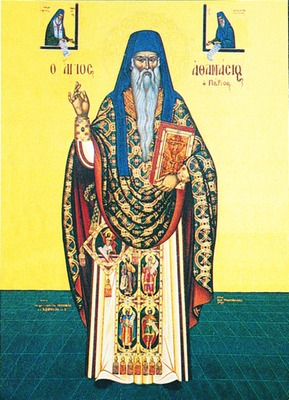
The future saint was a leading member of the Kollyvades movement which began on Mount Athos in the middle of the eighteenth century. The movement derives its name from the koliva (boiled wheat) which is used during memorial services. Its proponents were Athonite monks who adhered strictly to holy Tradition, and were opposed to unwarranted innovations. They were in favor of the frequent reception of Holy Communion, and they practiced unceasing prayer of the heart. They insisted that memorial services should not be performed on Sundays, because that is the day of the Lord’s Resurrection. In the Orthodox Church Saturday is the usual day for the commemoration of the dead.
St Athanasius went to Mount Athos in 1752. There he was ordained to the holy priesthood by St Macarius of Corinth (April 17), but was forced to leave the Holy Mountain when some of the monks rose in opposition to the Kollyvades. The righteous one was unjustly slandered for his views on frequent Communion and for his opposition to memorial services on Sundays.
As the result of personal attacks and intrigues against him, St Athanasius was suspended from exercising his priestly office from 1776—1781, and was even accused of being a heretic. When the charges against him were later proven to be absurd and unfounded, his suspension was lifted, and he was restored to his former rank.
St Athanasius knew and influenced many of his fellow Kollyvades, such as St Macarius of Corinth, St Nicephorus of Chios (May 1), St Arsenius of Paros (January 31), and St Nicodemus of the Holy Mountain (July 14). He taught St Nicephorus, and he encouraged St Nicodemus to publish a collection of the writings of St Gregory Palamas (November 14). Unfortunately, his manuscript was lost before it could be printed.
After teaching at the Athonias Academy and in Thessalonica, St Athanasius journeyed to the island of Chios in 1788, where he taught in the gymnasium for twenty-five years, and also served as Director of schools. He was a leading educator and distinguished theologian who revived the art of eloquent speech on Chios by teaching logic, rhetoric, metaphysics, and theology. His TREATISE ON RHETORIC, an analysis of some of the orations of Demosthenes, was a most influential work.
St Athanasius wrote many other useful books and treatises on various topics such as A HANDBOOK OF APOLOGETICS, “The Great Blessing of Water,” “On the Second Sunday of Great Lent,” “The Kneeling Prayers on Pentecost,” “On the Holy Icons,” “On Memorial Services,” “On the New Martyrs,” “On the Angels and Divine Beauty,” as well as numerous letters dealing with diverse subjects. His most important book was the EPITOME, which deals with Orthodox dogma.
St Athanasius was also a prolific writer of saints’ Lives and of liturgical services in their honor. He wrote the lives of St Mark the New (June 5) and St Macarius of Corinth, among others. He also wrote the Preface for the NEW LEIMONARION (New Spiritual Meadow), a collection of saints’ lives and services begun by St Macarius, with additional material contributed by St Nicephorus of Chios and by St Athanasius himself.
St Athanasius retired as Director of schools in 1812, and went to join St Nicephorus at the Hermitage of St George at Resta, Chios where he spent his final days. He departed to the Lord on June 24, 1813 at the age of ninety.
St Athanasius was very zealous for the teachings of Christ and His Church, and patiently endured persecution and suffering during his life because of his beliefs. Since he was opposed to the so-called Age of Enlightenment and fought against the “progressive” spirit of his time, he was censured by some of his contemporaries. Although his detractors enjoyed a certain fame during their lifetime, they are all but forgotten today. On the other hand, St Athanasius has been glorified by God and was officially recognized as a saint of the Orthodox Church in 1995.
